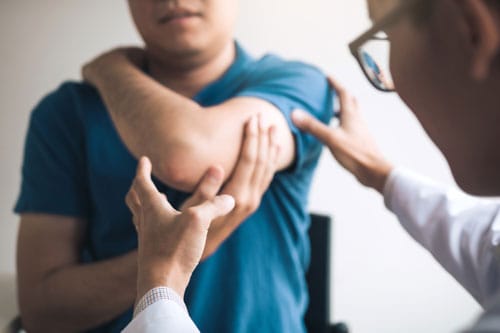No one plans to be in a car wreck, and most of us would prefer to put one behind us as soon as possible. That may be why so many people decline to have a full medical evaluation done after a collision. If you’re not bleeding and nothing seems to be broken, why bother?
It’s a common reaction—and a dangerous one. The impacts of a car accident can extend well beyond the obvious, such as broken bones and immediate pain. Some highly serious injuries, such as a concussion or traumatic brain injury, may not be evident right after the car accident. Even in seemingly “minor” crashes, there can be issues with soft tissue injuries that require urgent and ongoing treatment.
WHAT ARE SOFT TISSUE INJURIES?
The body’s soft tissue includes skin, fat, tendons, blood vessels, ligaments, and muscles (as opposed to the “hard tissue” of bones). Trauma to soft tissue can result from overuse, or from an acute injury — such as the sudden impact of a car crash. Some common forms of soft tissue damage from car accidents include sprains (stretching or tearing of ligaments), strains of muscles or tendons, contusions (bruising), and whiplash (sudden, back-and-forth movement of the head and neck that can cause sharp pain, back problems, headaches, and more).
DETECTING AND TREATING SOFT TISSUE INJURIES
Often an accident victim feels “sore” after the collision without realizing the true extent of the injury. Typically, many soft tissue injuries don’t show up on a standard X-ray. It takes other kinds of imaging equipment and physical examination to properly diagnose the injury.
The most common, least invasive treatment for soft-tissue injuries is called RICE, short for Rest, Ice, Compression, Elevation, a procedure which is generally effective for reducing swelling and inflammation. Your doctor may also urge physical therapy or immobilization of the sore area (such as a neck brace) to help with your recovery. Be advised, though, that soft tissue injuries can seem mild, yet symptoms can persist longer than you expected; a strained back, for example, can sometimes take longer to heal than a broken bone.
In certain cases, surgery may also be a viable treatment option if non-invasive procedures have not been effective. This might include surgery to repair a torn anterior cruciate ligament (ACL) in the middle of your knee or the medial collateral ligament (MCL) in the inner part of your knee, or to repair a torn rotator cuff in the shoulder.
SOFT TISSUE DAMAGE AND YOUR INJURY CASE
Your best course of action after a car accident is to get checked out medically as soon as possible. Even if you decline a trip to the emergency room in an ambulance, you should probably see your primary provider or visit a drop-in clinic within the first 24 hours after the accident to be evaluated. If it turns out that you may have experienced soft-tissue injuries, you should pursue diagnosis and appropriate treatment; at the very least, you are in a better position to document your injuries and get better than someone who delays seeking treatment. An experienced personal injury attorney can help not only in evaluating whether you have a claim for damages but in arranging for the right medical care and addressing the possible long-term impacts of your injuries.
THE CAR ACCIDENT LAWYERS AT FDAZAR
For more than thirty years the attorneys at Frank Azar Car & Truck Accident Lawyers have helped thousands of injured people obtain complete and timely compensation for their losses. Our proven track record and expertise have allowed us to grow into the largest personal-injury law firm in Colorado, with offices in Denver, Aurora, Thornton, Fort Collins, Greeley, Grand Junction, Colorado Springs, and Pueblo. If you’ve been injured in a bus, car, truck, or motorcycle accident, you may be entitled to compensation. Please call the car accident attorneys at FDAzar day or night or contact us here for a free consultation and no-obligation evaluation of your case.




